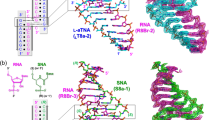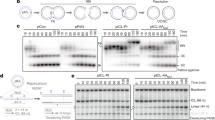Abstract
CHEMICAL carcinogens, for example, benzo[a]pyrene (BaP), are metabolised to reactive intermediates which bind covalently to cellular macromolecules1–3 and the extent of binding seems to correlate with the carcinogenic potency of the hydrocarbons1. Through various mutagenicity, metabolism and binding studies, the intermediate which undergoes formation of a stable covalent complex with DNA has been identified as 7β,8α-dihydroxy-9α,10α-epoxy-7,8,9,10-tetrahydrobenzo [a]pyrene (BaP diol epoxide)4–9. The structure of a covalent adduct formed between this hydrocarbon and poly(G) has also been established6–9. We report here the identity of several adducts obtained by reacting (±)BaP diol epoxide with tritium-labelled DNA. Four differently labelled lots of DNA were synthesised in vitro with DNA polymerase I by incorporating in each case three unlabelled and one tritium labelled nucleoside triphosphate. Through the use of this unambiguous labelling technique we have demonstrated that activated BaP forms two adducts with deoxyguanosine, two with deoxyadenosine and possibly one wtih deoxycytidine, while reaction with deoxy-thymidine was not detected. This approach also allowed the relative percentage of each adduct to be calculated. The deoxyguanosine adducts predominated and constituted 92% of the total stable covalent adducts formed.
This is a preview of subscription content, access via your institution
Access options
Subscribe to this journal
Receive 51 print issues and online access
$199.00 per year
only $3.90 per issue
Buy this article
- Purchase on Springer Link
- Instant access to full article PDF
Prices may be subject to local taxes which are calculated during checkout
Similar content being viewed by others
References
Brookes, P. & Lawley, P. D. Nature 202, 781–784 (1964).
Gelboin, H. V. Cancer Res. 29, 1272–1276 (1969).
Heidelberger, C. A. Rev. Biochem. 44, 79–121 (1975).
Sims, P., Grover, P. L., Swaisland, A., Pal, K. & Hewer, A. Nature 252, 326–328 (1974).
Meehan, T., Straub, K. & Calvin, M. Proc. natn. Acad. Sci. U.S.A. 73, 1437–1441 (1976).
Weinstein, I. B. et al. Science 193, 592–595 (1976).
Koreeda, M., Moore, P. D., Yagi, H., Yeh, H. J. & Jerina, D. M. J. Am. chem. Soc. 98, 6720–6722 (1976).
Huberman, E., Sachs, L., Yang, S. K. & Gelboin, H. V. Proc. natn. Acad. Sci. U.S.A. 73, 607–611 (1976).
Nakanishi, K. et al. J. Am. chem. Soc. 99, 258–260 (1977).
McCaustland, D. J. & Engel, J. F. Tetrahedron Lett. 30, 2549–2552 (1975).
Yagi, H., Hernandez, O. & Jerina, D. M. J. Am. chem. Soc. 97, 6881–6883 (1975).
Richardson, C. C., Inman, R. B. & Kornberg, A. J. molec. Biol. 9, 46–69 (1964).
Jennette, K. W. et al. Biochemistry 16, 932–938 (1977).
Yang, S. K., McCourt, D. W., Roller, P. P. & Gelboin, H. V. Proc. natn. Acad. Sci. U.S.A. 73, 2594–2598 (1976).
King, H., Thompson, M. & Brookes, P. Cancer Res. 34, 1263–1269 (1975).
Thompson, M., King, H., Osborne, M. & Brookes, P. Int. J. Cancer 17, 270–274 (1976).
Gamper, H. B., Tung, A., Straub, K., Bartholomew, J. C. & Calvin, M. Science 197, 671–674 (1977).
Singer, B. Nature 264, 333–339 (1976).
Landolph, J. R., Bartholomew, J. C. & Calvin, M. Cancer Res. 36, 4143–4151 (1976).
Dipple, A. & Roberts, J. J. Biochemistry 16, 1499–1503 (1977).
Wislocki, P. G. et al. Biochem. biophys. Res. Commun. 68, 1006–1012 (1976).
Newbold, R. F. & Brookes, P. Nature 261, 52–54 (1976).
Author information
Authors and Affiliations
Rights and permissions
About this article
Cite this article
MEEHAN, T., STRAUB, K. & CALVIN, M. Benzo[a]pyrene diol epoxide covalently binds to deoxyguanosine and deoxyadenosine in DNA. Nature 269, 725–727 (1977). https://doi.org/10.1038/269725a0
Received:
Accepted:
Issue Date:
DOI: https://doi.org/10.1038/269725a0
This article is cited by
-
Mapping and characterization of mutations induced by benzo[a]pyrene diol epoxide at dihydrofolate reductase locus in CHO cells
Somatic Cell and Molecular Genetics (1988)
-
Liquid chromatographic characterization of the deoxyribonucleoside-5’-phosphates and deoxyribonucleoside-3’,5’-bisphosphates obtained by32P-postlabeling of DNA
Chromatographia (1987)
-
Fifty years of benzo(a)pyrene
Nature (1983)
-
Effects of 3,4-benzopyrene on the course of cell cycle events in the chlorococcal alga Scenedesmus quadricauda
Planta (1983)
-
Nucleic acid adducts of chemical carcinogens and mutagens
Archives of Toxicology (1983)
Comments
By submitting a comment you agree to abide by our Terms and Community Guidelines. If you find something abusive or that does not comply with our terms or guidelines please flag it as inappropriate.



